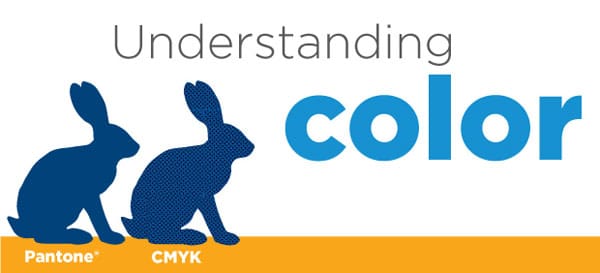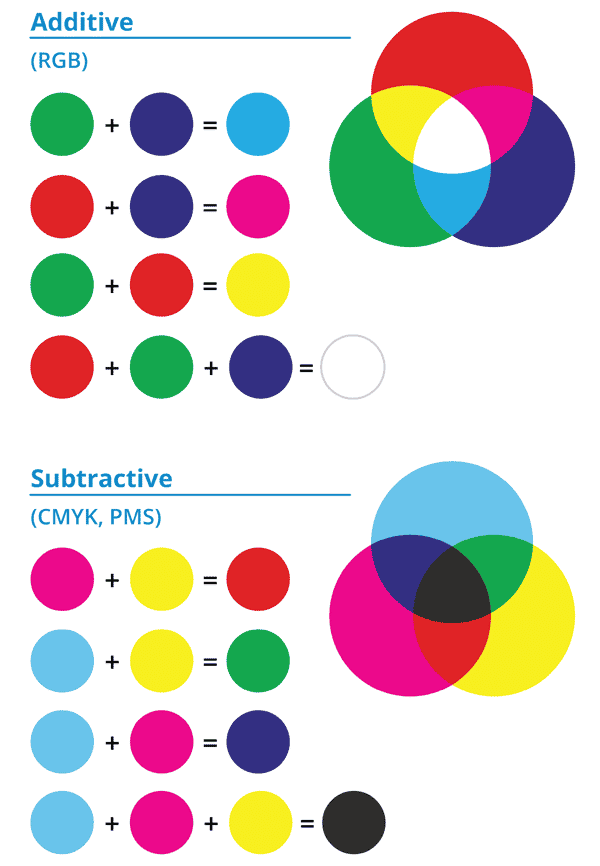
CMYK, Pantone, and RGB are three different color systems in graphic design and printing. Knowing what each of them means may be the difference between a perfect final draft and a project that looks completely different than what you expected.
But First, a Little Art and Physics
You’ve probably mixed paint together before, like red and green to get a murky brown. This is called subtractive color mixing.
However, if you shine red and green spotlights together on a wall, they mix to make yellow. This is additive color mixing. In additive color mixing, you get white when you mix red, green, and blue. It’s counterintuitive, and a little spooky the first time you see it — but it’s true!

This is the same thing that happens on your computer screen. Little pinpoints of red, green, and blue light (RGB) blend together and create the array of colors you’re looking at right now.
The problem is, if you’re a graphic designer working on your laptop, how can you ensure that the colors you’re seeing are going to translate to online and offline media?
Before we get into the details of converting Pantone to RGB or CMYK to PMS, let’s define these color systems.
CMYK Color
If you remember learning about primary colors in grade school, you have a good start for understanding how CMYK works. CMYK stands for cyan, magenta, yellow, and black (the “k” comes from the word “key,” a printing term). You can mix these four colors to get an array of secondary and tertiary colors like violet, orange, and just about every color from your kindergarten crayon box.
However, the one pitfall of CMYK is that different brands of ink tend to have color palettes that vary from each other. If you’re using different printers for your branded materials, your colors may not be 100% consistent.
Pantone (PMS) Color
Unlike CMYK, Pantone uses a standardized color reproduction system referred to as the PMS color process (Pantone Matching System). Each Pantone color, or “spot color”, has a unique identification number.
This system allows you to take your Pantone color to any printer on the planet and have your project come out with exactly-matching hues. And if you’re a brand that relies heavily on a very specific color (think “Home Depot Orange,” “Coca-Cola Red”, or “Barbie Pink”), you can see why Pantone would be invaluable.
The only down side to the PMS system is that your options are slightly more limited than CMYK. Because Pantone has a predetermined set of colors, you’ll have to work within their system. In other words, you can’t create any color and translate it flawlessly to Pantone.
Instead, your color-picking process is more like when you visit the paint section at the hardware store. You select from a range of shades available to you, and an employee mixes that exact shade for you to take home.
RGB Color
As we mentioned up top, RGB uses three colors (red, green, and blue) in different combinations to create every color of the rainbow. On computers, TVs, and mobile devices there are small dots of light in your screen that emit different amounts of red, green, and blue. Your eyes interpret these mixtures as different individual colors. RGB uses a subtractive color mixing process to create all colors, where RGB together makes white and the absence of red, green, and blue makes black.
Which Color System Should I Use?
Is CMYK “better” than Pantone, or RGB? No one system is inherently better, but one may be better for the project you’re working on.
The PMS process allows you to keep your colors consistent no matter where, or what, you print. This is useful if you’re a larger company with vendors across the globe: you can rest easy knowing your logo is going to look the same on a business card or a giant banner at a convention on the other side of the country.
On the other hand, if you’re printing fine art or photographs, you may find Pantone to be limiting. Pantone colors don’t blend easily, so you’ll probably need CMYK to get the variance you need.
And don’t forget to consider the type of printer you’re using. If you’re doing digital printing, Pantone colors don’t translate well on paper, so you’ll want to opt for CMYK.
However, with offset printing, you can take your pick: both CMYK and Pantone produce great results.
Combining CMYK and Pantone in One Design
You don’t always have to stick with one color system in a single design project. In fact, you may be able to achieve exactly the look you need — and save some money — by combining Pantone and CMYK inks.
This is called spot-color printing, or “five color process.” When you print this way, you use a mixture of the standard CMYK colors, but you also add one or two Pantone colors to get specific hues just right.
For example, imagine you’re Coca-Cola and you’re printing the billboard pictured above. Coca-Cola red is a very specific color, and needs to remain consistent across all branded materials — this billboard included.
However, some of the other elements of the design, like the colors of the bottle and soda, don’t need to be as exact. For the most cost-effective process, you would use a Pantone for Coca-Cola red, and CMYK for everything else.
If you were to see the printing press running for this job, you’d see one plate with the red PMS color for the Coke logo, and four other printing plates with CMYK blends to get the color just right.
Converting Between Color Systems
With the prevalence of web design and digital design today, it’s common to have to do color conversions between these three main systems when creating printed materials. Here’s a basic rundown of what to expect when converting between RGB, CMYK, and Pantone, along with links to more detailed tutorials.
RGB Conversions
RGB is used for digital rendering and can have issues when being reproduced with a CMYK or Pantone process. However, sometimes you may be working with a design that originated in RGB and needs to be converted for print. You can usually get your final design close to the original, but know that there are some colors in RGB that simply can’t be reproduced in CMYK or Pantone.
RGB to CMYK
- RGB to CMYK online converter
- Converting RGB to CMYK in different programs
- The differences in appearance between RGB and CMYK
RGB to Pantone (PMS)
CMYK Conversions
With most CMYK colors, there is a matching Pantone color out there. The same goes for CMYK to RGB. Most graphic design programs have a built-in process for converting CMYK to Pantone, but you can also use an online tool to make these conversions.
CMYK to RGB
- CMYK to RGB online converter
- How CMYK and RGB are different onscreen
CMYK to Pantone (PMS)
Pantone (PMS) Conversions
Converting Pantone to either RGB or CMYK isn’t problematic for most colors. However, if you’re working with a metallic, pastel, or fluorescent hue, Pantones don’t always convert well to CMYK.
PMS to RGB
PMS to CMYK
